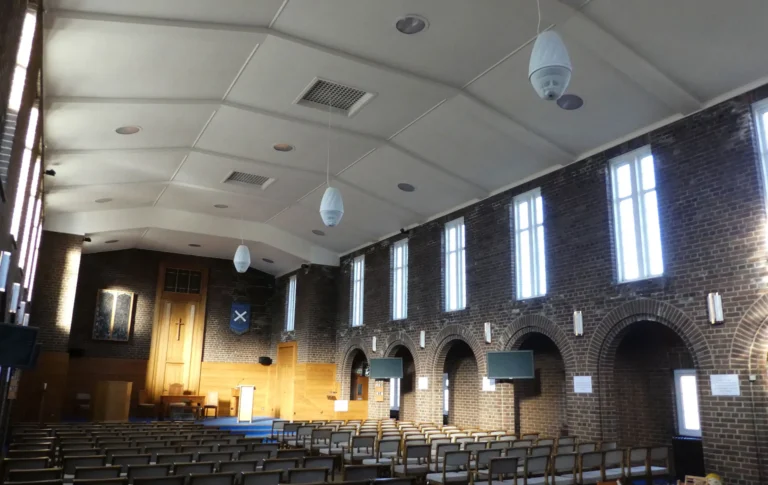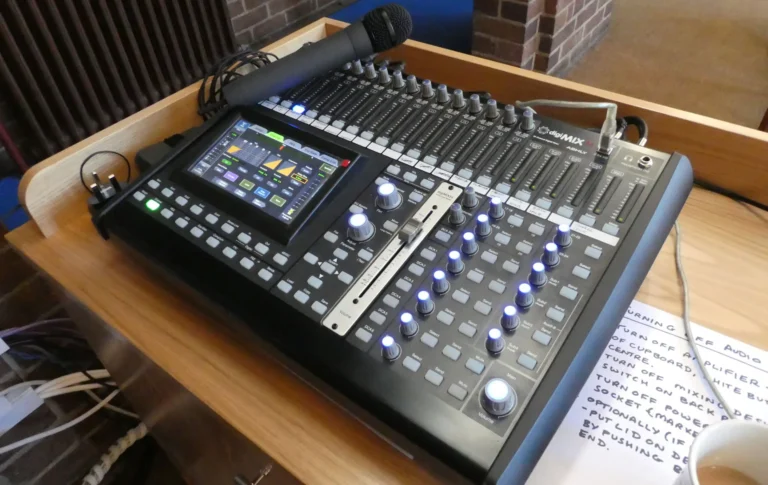Case StudY
St Andrew's United Reform Church
Working alongside a consultant and integrator, a church elder has overseen the conversion from analogue to digital at a local church in northern England which could transform its future.
A community church in a small town in northern England isn’t the natural habitat for high-end networked AV systems, but that is what St. Andrew’s United Reform Church in Monkseaton is now home to.
Built in 1933, the church is typical of thousands across the UK, in that it hosts a variety of events, secular and non-secular, every month, catering for the whole community. Like most churches, volunteers play a large part in maintaining the upkeep of the church, including the technology.

However, such work had resulted in the original balanced sources and cabling to be terminated in unbalanced connectors. In addition the mixer and amplifier didn’t give much control over the sound levels and tone. Also, during the relocation of the amp from the front to the rear of the church, and also following modifications to the layout of the chancel area, the original speaker and microphone cables had been spliced together with newer cabling of various types and was causing degradation of the signals coming from the microphones and going to the speakers. Local systems integrator MRM Solutions was brought on board for the installation.
MRM handled all the cabling (audio and IT network), cabinet and loudspeaker installation. The installation took place over four weeks, but access was limited to 1.5 hours a day in some rooms due to the venue (and the existing audio systems) being in regular use.
What were the challenges for the integrator on this project? “The hardest part was getting cables from the ground floor of the church up to the loft area,” says Chris Darling, operations director, MRM. “Luckily the cables came through a grill in the loft space so we didn’t have to do any drilling in the ceiling.”
In the church three Sound Tube RS102i-T64 3-way 10-in pendant speakers are hung from the ceiling along the central spine. Getting the speakers to be exactly the same height took a lot of care says Darling. Two additional Sound Tube SM890i loudspeakers were also wall-mounted in the church to give stereo reproduction. One Ashly Audio NX4004 amplifier has been installed in the rear of the church powering the pendant speakers, and a Bittner XB800 amp has been fitted in the front of the church for the 890is.

An additional Ashly Audio E8250 amp was installed in the main hall, connected to existing speakers in the main hall and other rooms, plus a pair of Sound Tube SM500I-II that give stereo reproduction for the churches monthly film club showings. “The advantage of the amp in the main hall was the ability to configure all the inputs, DSP, and zoned routing to outputs via the Ashly Protea software on a laptop, with a pre-set configuration for normal use, but the ability to easily change to a completely different configuration for special events. The connected WR-5 wall remote means users just need to push a few buttons to select which speakers they want to use and whether to enable the feed in from the main church,” says Cooke. “They can also adjust the overall volume via the unit, whilst the volume controls on the front of the amp have been disabled to stop people fiddling and mixing up the balance.”
In the church, and the central point of the new audio installed, is an Ashly Audio digiMIX24 digital mixing console. The system in the church is connected via a Dante network, which although not unusual in a large state-of-the-art house of worship, is rare in a church of this size, so why go digital? “When we first got in touch with Sound Directions they initially proposed an analogue system, and that was going to be the plan,” says Cooke. “We were going to run a 16×4 Snake from a wallbox at the front of the church, where we were going to plug in all the microphones we wanted, to the back of the church into whatever analog mixer we put in.” So why did they change their minds, and make the move from analog to digital? “It was partly the logistics of trying to run a snake from the front of the church to the back and then get it through a half-metre brick wall, from where it would have been run to where the mixing desk would have been,” adds Cooke.

“It was going to be really difficult to put all the terminated XLR connectors from a snake through a wall like that. It was at that point Sound Directions suggested a Dante-enabled network run over IP. The price difference wasn’t that much because it was going to involve less infrastructure work. All we needed to add was a few Cat6 cables, instead of a big snake and all the other cabling. Having to install a PoE network switch to support the Dante devices was an extra expense, but it was realised that would also facilitate Internet and WiFi connectivity as incidental projects identified during the original IT survey.”
“It’s not a massive building, sitting in a footprint 35m wide by 30m deep, so we could have run it all analogue, but when Dante was suggested, it became obvious we could keep it simple to start with and expand later. We put in the network cabling, with a PoE switch and a small Dante breakout box at the front of the church (to connect the microphones in the Chancel area of church to), then feed via Dante network to the mixer at the back, where radio mics and other devices are also connected.
The Dante network also extends through to the Ashly amp in the hall, enabling audio to be heard throughout the whole building when required. The Digimix24, Auvitran BOB and 8250 amp are also networked, which allows us to manage them remotely via a laptop or the Ashly iPad app. If we have any big concerts we have the option to hire in another Dante breakout box and some more microphones, and we can run it all off the same Digimix24 mixer. Dante will make it a lot easier, as time progresses and we find our needs change, to be able to expand and reconfigure the system”.
With the new system still bedding in, what would Cooke say was the biggest difference the installation has made so far? “It’s definitely the sound quality it has given us. It has also given us a simplistic day-to-day setup for running services – we are close to having the scenario where we have a system you can just turn on and even non-techies can operate it – but we also have the expandability that enables us to facilitate much bigger events in the future and the ability to take advantage of digital sound and Internet connectivity to make the church more accessible to those who can’t physically attend. Those were the main aims for the project, and thanks to Sound Directions and MRM Solutions we achieved it, all within budget and on time.”
Copy: © 2017 Paul Milligan, Inavate
Equipment List: Ashly Digimix 24 Digital Mixer with Dante, Ashly NX4004 Amplifier with Dante, Ashly Ne8250 Amplifier with Dante, Auvitran AVDTB-BOB Dante Interface, Bittner XB800 Amplifier, SoundTube Pendant Speakers, SoundTube Wall Speakers
